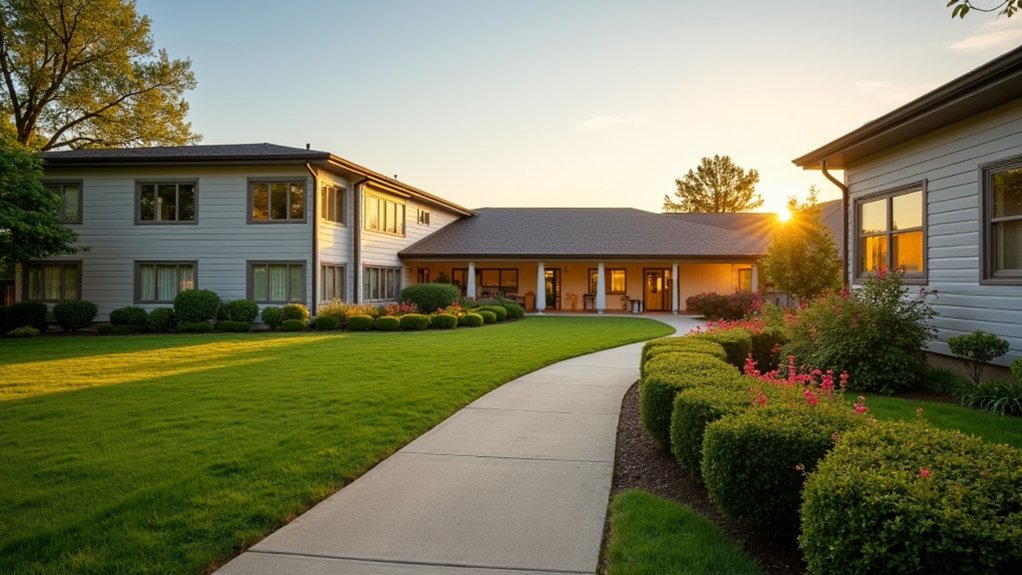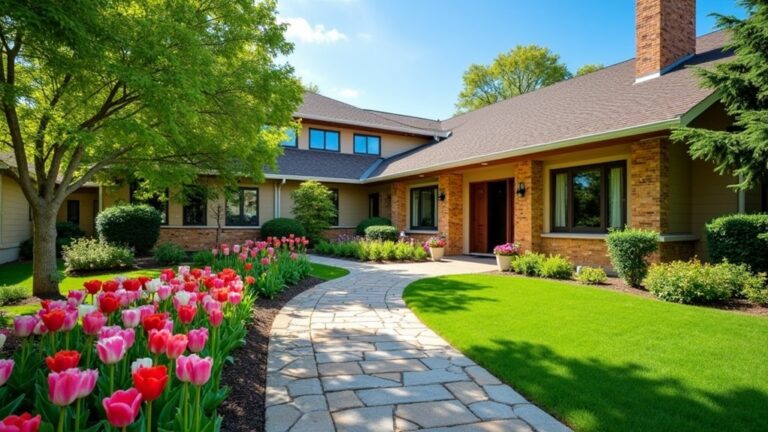7 Best Insights on Residential Care Facility Costs

Maneuvering residential care facility costs can be tough, but here’s what you need to know. First, costs depend on medical needs and location—urban spots are pricier. Second, assisted living ranges $3,000-$5,000 monthly, while nursing homes hit $7,000-$10,000. Third, watch for hidden fees like extra care or activities. Fourth, regional rates vary widely. Fifth, funding options include Medicaid or personal savings. Sixth, staffing ratios impact pricing. Seventh, future tech may lower costs. Curious? Stick around for deeper insights.
Key Takeaways
- Residential care costs vary widely, influenced by location, with urban areas often charging more than rural regions.
- Assisted living typically costs $3,000-$5,000 monthly, while nursing homes range from $7,000-$10,000 for intensive care.
- Hidden fees for personal care, medication, or activities can increase expenses; request detailed cost breakdowns upfront.
- Funding options like Medicaid, veterans’ benefits, or private insurance can help offset residential care expenses.
- Regional disparities impact pricing, with high-demand areas like California often exceeding $5,000 monthly for private rooms.
Key Factors Influencing Residential Care Expenses

As you explore the costs of residential care, you’ll quickly notice that several key factors drive expenses.
First, consider the level of medical support needed. If your loved one requires frequent health monitoring or specialized treatments, costs rise due to skilled staff and equipment. You’re investing in their safety and well-being, which is paramount when serving others.
Another factor is the location of the facility. Urban centers often charge more due to higher operational costs, while rural options might be more affordable. Think about what’s accessible for family visits to maintain connection.
Additionally, the range of amenities impacts pricing—facilities offering enriching activities or private rooms cost more, but they enhance quality of life.
Finally, staffing ratios play a role; more caregivers per resident guarantee personalized attention, reflecting your commitment to their comfort. Understanding the breakdown of expenses can help in making informed decisions about the right facility for your loved one.
Weigh these elements carefully as you make this heartfelt decision for someone you cherish.
Comparing Different Types of Care Home Fees
While exploring residential care options, you’ll find that fees vary widely depending on the type of care home. As someone dedicated to helping others, you’ll want to understand these differences to guide loved ones or clients effectively.
Assisted living facilities often cost less, offering support with daily tasks like dressing or meals, typically ranging from $3,000 to $5,000 monthly. Nursing homes, providing intensive medical care, can run between $7,000 and $10,000 per month due to skilled staff and equipment.
Memory care units, tailored for dementia patients, might fall in a similar range but include specialized programs for safety and engagement. Choosing between these options requires understanding the medical care levels needed to ensure your loved one receives appropriate support.
When comparing, consider the level of care needed. You’re not just looking at price; you’re ensuring the right environment for well-being.
Research each option thoroughly, visit facilities, and ask about included services to match needs with budgets, making a compassionate, informed choice for those you serve.
Hidden Charges in Residential Care Pricing

Have you ever wondered what’s really included in the price of a residential care facility? When you’re helping a loved one find the right place, you might assume the quoted rate covers everything.
But often, hidden charges sneak into the bill, catching you off guard. These can include fees for extra personal care, medication management, or even laundry services. You’re dedicated to guaranteeing the best for those you serve, so it’s vital to ask for a detailed breakdown of costs upfront.
Don’t hesitate to dig deeper—request a list of all potential add-ons before signing any agreement. Some facilities might charge for social activities or specialized therapies that seem essential but aren’t included in the base rate. Additionally, be aware that Medicaid coverage varies by state, which may influence the overall costs and services provided at the facility.
Regional Variations in Care Facility Rates
Let’s shift focus to how residential care facility costs can vary widely depending on where you’re located. As someone dedicated to helping others, you’ll want to understand these differences to better guide families in need.
In urban areas, especially in high-demand regions like California or New York, you’ll often find rates considerably higher due to elevated living costs and limited availability. A private room might cost over $5,000 monthly in these spots.
Meanwhile, if you’re in rural or less populated areas, such as parts of the Midwest, you might see costs drop to around $2,500 or less per month for similar care.
These variations stem from local economic factors, staffing expenses, and property values. When you’re advising loved ones or clients, consider these regional disparities. They’ll help you tailor solutions that align with both care needs and financial realities in your specific area. Additionally, understanding the costs associated with assisted living can provide a comprehensive perspective on budgeting for care.
Funding Sources for Residential Care Services

As you explore options for residential care, understanding the funding sources available can make a significant difference in planning. You’re likely driven by a heartfelt desire to guarantee the best for those in need, and knowing where to find financial support is key.
Start with government programs like Medicaid, which often covers costs for eligible low-income individuals in residential care settings. Medicare may also assist, though typically for short-term rehabilitative care rather than long-term stays.
Explore government aid like Medicaid for low-income individuals in residential care, while Medicare often supports short-term rehabilitative needs.
Additionally, consider private insurance plans; some policies include long-term care benefits if you’ve planned ahead. Veterans’ benefits can be a lifeline if the person you’re helping has served in the military—check with the VA for specifics.
Finally, personal savings or family contributions might play a role. By tapping into these resources, you’ll provide the care and dignity those you serve truly deserve, easing their journey with compassion. It’s also important to consider financial resources that must be assessed to determine eligibility for various care options.
Strategies to Manage Care Home Budgets
While steering through the costs of residential care, you’ll find that crafting a solid budget strategy is essential for financial stability. As someone dedicated to serving others, you can prioritize the well-being of residents by managing funds wisely.
Start by tracking every expense meticulously—know where each dollar goes, from staff salaries to daily supplies. Cut unnecessary costs without compromising care quality; for instance, negotiate with vendors for better rates on essentials.
Next, build a reserve fund for unexpected expenses—emergencies happen, and you’ll want to be prepared to support your community. Involve your team in budget planning; their insights can uncover savings opportunities. Additionally, understanding payment plans and fees structure can help in making informed financial decisions.
Finally, regularly review your budget to adjust for changing needs, ensuring you’re always aligned with your mission to provide exceptional care. With these strategies, you’ll maintain financial health while focusing on what matters most—serving those who depend on you.
Future Trends in Residential Care Pricing
Looking ahead, you’ll notice that residential care pricing is set to evolve with changing economic and demographic trends. As you work to support those in need, understanding these shifts can help you plan better.
Aging populations are growing, increasing demand for facilities and likely driving costs up. Meanwhile, inflation and labor shortages may push prices higher as facilities cover rising operational expenses.
Growing aging populations are boosting demand for care facilities, driving up costs, while inflation and labor shortages further increase operational expenses.
On a positive note, you’re likely to see technology play a bigger role in care, potentially reducing some costs through automation and efficiency. Government policies might also adapt, offering subsidies or incentives to make care more affordable. Additionally, assisted living facilities are increasingly focusing on tailored care plans, which may influence overall pricing structures.
As someone dedicated to serving others, you can advocate for transparent pricing models and stay informed about regional trends. By anticipating these changes, you’ll be better equipped to guide families and guarantee access to quality care without financial strain.
Frequently Asked Questions
What Is the Average Staff-To-Resident Ratio?
Hey, you’re probably wondering about the average staff-to-resident ratio in residential care facilities. It’s a key factor when you’re looking to guarantee loved ones get the attention they deserve.
Typically, you’ll find ratios around 1:6 to 1:10, depending on the facility and care level needed. Check specific places you’re considering, as this varies widely.
You’ve got the power to advocate for quality care—dig deeper and ask questions!
Are Pets Allowed in Care Facilities?
Hey there, are pets allowed in care facilities? You’re wondering about this because you want to guarantee comfort for those you serve.
Check the specific facility’s policies, as they vary widely. Some welcome pets to boost emotional well-being, while others can’t due to health or safety concerns.
Reach out directly, ask questions, and advocate for residents’ needs. Your dedication to their happiness truly makes a difference in their lives!
What Activities Are Offered to Residents?
Wondering what activities are offered to residents in care facilities? You’ll find a variety of engaging options to brighten their days!
Immerse yourself in organizing arts and crafts, group games, or exercise classes to keep spirits high.
Don’t miss out on facilitating music therapy or gardening clubs that foster joy and connection.
You’re making a difference by ensuring residents enjoy enriching, social experiences tailored to their interests and needs.
How Often Are Family Visits Permitted?
Wondering how often you can visit your loved ones in a residential care facility?
You’re welcome to stop by as often as you’d like, though most facilities set specific visiting hours to guarantee residents’ routines aren’t disrupted.
Check with the staff to confirm the schedule and any guidelines.
Your presence brings comfort, so make those visits count by planning ahead and showing up with a caring heart!
What Are the Facility’s Safety Measures?
Hey, you’re wondering about the facility’s safety measures, and I’m glad you’re looking out for your loved ones.
Rest assured, you’ll find robust protocols here. Check for 24/7 security staff, surveillance cameras, and emergency response systems in every room.
Make sure they’ve got fire safety drills and secure entry points. Ask about staff training for emergencies—you’ll want everyone prepared to keep residents safe and sound at all times.






